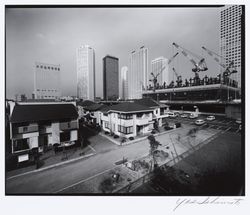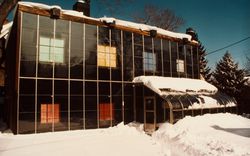archives
Niveau de description archivistique:
Fonds
Fonds John Hejduk
AP145
Résumé:
The John Hejduk fonds documents the professional practice of architect John Hejduk. Drawings of nearly every project by Hejduk are present, with many of his most significant architectural, exhibition, and publishing projects particularly well represented. Material in this fonds was produced between 1947 and 2000.
1947-2000, predominant 1947-1996
Fonds John Hejduk
Actions:
AP145
Résumé:
The John Hejduk fonds documents the professional practice of architect John Hejduk. Drawings of nearly every project by Hejduk are present, with many of his most significant architectural, exhibition, and publishing projects particularly well represented. Material in this fonds was produced between 1947 and 2000.
archives
Niveau de description archivistique:
Fonds
1947-2000, predominant 1947-1996
archives
Niveau de description archivistique:
Fonds
CP138
Résumé:
The Gordon Matta-Clark collection documents the personal and professional activities of Gordon Matta-Clark through his correspondence, texts, library, artwork and films, created predominantly between 1969 and 1978. Additionally the collection contains correspondence and photographs collected by Anne Alpert, Matta-Clark's mother, and documentation on his work collected by his widow Jane Crawford following his death.
1914-2008
Collection Gordon Matta-Clark
Actions:
CP138
Résumé:
The Gordon Matta-Clark collection documents the personal and professional activities of Gordon Matta-Clark through his correspondence, texts, library, artwork and films, created predominantly between 1969 and 1978. Additionally the collection contains correspondence and photographs collected by Anne Alpert, Matta-Clark's mother, and documentation on his work collected by his widow Jane Crawford following his death.
archives
Niveau de description archivistique:
Collection
1914-2008
Sous-série
AP156.S4.SS5.D10
Description:
Le dossier documente les photographies prises par un ou des photographes non identifiés de Chandigarh, en Inde. Le dossier inclut des photographies de la vie quotidienne à Chandigarh, des paysages de Chandigarh, des résidences privées et gouvernementales, des écoles, de l'Université du Panjab, du Capitol, de divers bâtiments et installations, de maquettes, de mobilier créé par Pierre Jeanneret et des signes de Le Corbusier. Le matériel dans ce dossier a été produit entre 1950 et ls années 1970. Le dossier contient des photographies. File documents the photographs taken by unidentified photographers. The file includes photographs of the everyday life at Chandigarh, Chandigarh's landscapes, private and governmental residences, schools, the Panjab University, the Capitol, miscellaneous buildings and installations, models, furniture designed by Pierre Jeanneret and Le Corbusier's signs. The material in this file was produced between 1950 and in the 1970s. The file contains photographs.
1950-1970s
Photographes inconnus = Unknown photographers
Actions:
AP156.S4.SS5.D10
Description:
Le dossier documente les photographies prises par un ou des photographes non identifiés de Chandigarh, en Inde. Le dossier inclut des photographies de la vie quotidienne à Chandigarh, des paysages de Chandigarh, des résidences privées et gouvernementales, des écoles, de l'Université du Panjab, du Capitol, de divers bâtiments et installations, de maquettes, de mobilier créé par Pierre Jeanneret et des signes de Le Corbusier. Le matériel dans ce dossier a été produit entre 1950 et ls années 1970. Le dossier contient des photographies. File documents the photographs taken by unidentified photographers. The file includes photographs of the everyday life at Chandigarh, Chandigarh's landscapes, private and governmental residences, schools, the Panjab University, the Capitol, miscellaneous buildings and installations, models, furniture designed by Pierre Jeanneret and Le Corbusier's signs. The material in this file was produced between 1950 and in the 1970s. The file contains photographs.
Dossier 10
1950-1970s
Tokyo : Yasuhiro Ishimoto
Après avoir vécu une grande partie de sa vie aux États-Unis, le photographe Yasuhiro Ishimoto (1921-2012) s’installe définitivement à Tokyo à partir de 1961. Là, il amorce une étude de la ville qui se distingue des photographies de rue que réalisent ses contemporains. Au cours des 50 années qui suivent, Ishimoto représente essentiellement les espaces changeants et la(...)
Vitrines
28 juin 2012 au 21 octobre 2012
Tokyo : Yasuhiro Ishimoto
Actions:
Description:
Après avoir vécu une grande partie de sa vie aux États-Unis, le photographe Yasuhiro Ishimoto (1921-2012) s’installe définitivement à Tokyo à partir de 1961. Là, il amorce une étude de la ville qui se distingue des photographies de rue que réalisent ses contemporains. Au cours des 50 années qui suivent, Ishimoto représente essentiellement les espaces changeants et la(...)
Vitrines
Les bâtiments de pierre grise qui se dressent aujourd’hui dans Montréal sont des outils essentiels pour comprendre la ville. Une étude en profondeur de leur histoire matérielle depuis le XVIIe jusqu’au début du XXe siècle démontre comment la géologie, la topographie, les politiques, l’ethnicité, la culture, ainsi que les changements économiques et(...)
Salle octogonale Mot(s)-clé(s):
Greystone, pierre grise, Phyllis Lambert, Montréal, photographie, Richard Pare
13 octobre 2017 au 4 mars 2018
Pierre grise : des outils pour comprendre la ville
Actions:
Description:
Les bâtiments de pierre grise qui se dressent aujourd’hui dans Montréal sont des outils essentiels pour comprendre la ville. Une étude en profondeur de leur histoire matérielle depuis le XVIIe jusqu’au début du XXe siècle démontre comment la géologie, la topographie, les politiques, l’ethnicité, la culture, ainsi que les changements économiques et(...)
Salle octogonale Mot(s)-clé(s):
Greystone, pierre grise, Phyllis Lambert, Montréal, photographie, Richard Pare
articles
Notre client, la planète
articles
Notre client, la planète
Le modernisme entre préservation et progrès : Van Ginkel Associates, direction Nord
Jordan B. Kinder
salle d'étude Mot(s)-clé(s):
Jordan Kinder; séminaire; pipeline; Van Ginkel Associates
3 août 2023, 18h à 19h30
salle d'étude Mot(s)-clé(s):
Jordan Kinder; séminaire; pipeline; Van Ginkel Associates
Sous-série
AP207.S2.SS09
Description:
The sub-series documents the exhibition "Radicals. Architettura e design 1960-1975", curated by Pettena and presented in the Italian Pavilion at the Venice Biennale in 1996. This documentary exhibition on the Radical architecture movement in the 1960s and the 1970s, for presented the Radical movement not as "essentially conceptual contribution, as “fantastic” theories and utopian visions of the future" [1] but as "precursors of the most innovative production of the contemporary, international architectural scene." [2] The sub-series contains research material, including photocopies of articles on the Radical movement and research on previous editions of the Venice Biennale. It also contains correspondence for the planning of the exhibition, including with Hans Hollein and the Biennale administration, a draft exhibition proposal, concept development notes by Pettena, proposals for promotional material on the exhibition and press clippings. Source: [1][2] Gianni Pettena website, https://www.giannipettena.it/english/exhibitions/settings/ (last accessed 29 January 2020).
1992-2010
Radicals. Architettura e Design 1960-1975 (1992)
Actions:
AP207.S2.SS09
Description:
The sub-series documents the exhibition "Radicals. Architettura e design 1960-1975", curated by Pettena and presented in the Italian Pavilion at the Venice Biennale in 1996. This documentary exhibition on the Radical architecture movement in the 1960s and the 1970s, for presented the Radical movement not as "essentially conceptual contribution, as “fantastic” theories and utopian visions of the future" [1] but as "precursors of the most innovative production of the contemporary, international architectural scene." [2] The sub-series contains research material, including photocopies of articles on the Radical movement and research on previous editions of the Venice Biennale. It also contains correspondence for the planning of the exhibition, including with Hans Hollein and the Biennale administration, a draft exhibition proposal, concept development notes by Pettena, proposals for promotional material on the exhibition and press clippings. Source: [1][2] Gianni Pettena website, https://www.giannipettena.it/english/exhibitions/settings/ (last accessed 29 January 2020).
Subseries
1992-2010
Série(s)
Photographies = Photographs
AP156.S4
Description:
La série documente la vie personnelle et professionnelle de Pierre Jeanneret, en Europe et en Inde, ainsi que le projet de la nouvelle ville de Chandigarh, en Inde. La série inclut principalement des photographies de Chandigarh, mais aussi des photographies de familles, des photographies de quelques projets qu'il a réalisé en Europe dans les années 1940. Le matériel de cette série a été produit entre la fin des années 1800 jusqu'au années 1970. La série contient principalement des photographies, donc des épreuves contacts ou des photocollages, ainsi que des négatifs. Series documents the personnal and professional life of Pierre Jeanneret, in Europe and in India, and also the project for the new city of Chandigarh, in India. The series includes predominantly photographs of Chandigarh, but also family photographs and photographs of a few of his projects in Europe in the 1940s. The material in this series was produced between the end of the 1800s to the 1970s. The series contains predominantly photographs, including contact sheets and photocollages, and also negatives.
Photographies = Photographs
Actions:
AP156.S4
Description:
La série documente la vie personnelle et professionnelle de Pierre Jeanneret, en Europe et en Inde, ainsi que le projet de la nouvelle ville de Chandigarh, en Inde. La série inclut principalement des photographies de Chandigarh, mais aussi des photographies de familles, des photographies de quelques projets qu'il a réalisé en Europe dans les années 1940. Le matériel de cette série a été produit entre la fin des années 1800 jusqu'au années 1970. La série contient principalement des photographies, donc des épreuves contacts ou des photocollages, ainsi que des négatifs. Series documents the personnal and professional life of Pierre Jeanneret, in Europe and in India, and also the project for the new city of Chandigarh, in India. The series includes predominantly photographs of Chandigarh, but also family photographs and photographs of a few of his projects in Europe in the 1940s. The material in this series was produced between the end of the 1800s to the 1970s. The series contains predominantly photographs, including contact sheets and photocollages, and also negatives.
Série 4




